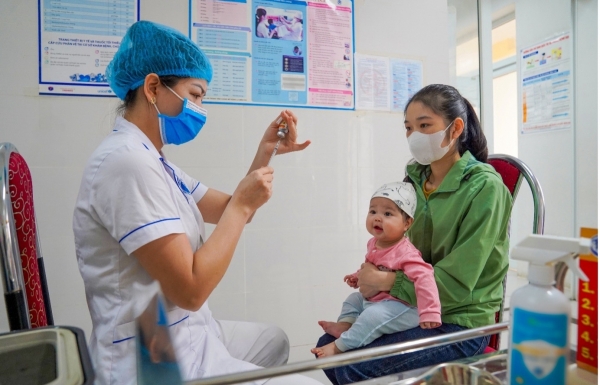INTERNATIONAL INVESTMENT
AND PORTAL
The pandemic has taken a turn for the worse in some parts of the world, including in Asia. The global economy is projected to grow by 5.9 per cent in 2021 and by 4.9 per cent in 2022. In particular, the 2021 Asian outlook has been downgraded by more than 1 percentage point to 6.5 per cent because of new outbreaks.
 By Francois Painchaud Resident representative International Monetary Fund in Vietnam
By Francois Painchaud Resident representative International Monetary Fund in Vietnam
As vaccination rates accelerate, the region is expected to grow slightly faster than previously anticipated in 2022. The overall global growth is expected to remain supportive of Vietnam’s economic recovery, though the global recovery has been accompanied by increasing commodity and producer prices.
Continued efforts to vaccinate the population are critical to normalising economic activity further as the pandemic has significantly affected households and businesses. Labour force participation and employment fell to the lowest levels in a decade, and labour shortages in manufacturing industries emerged as migrant workers in the hardest-hit areas returned home. Economic dualism and inequality have likely been exacerbated as lower-income households and small- and medium-sized enterprises in contact-intensive sectors were hit hardest, while higher-income households and larger firms have remained resilient.
But there are signs of a tentative recovery. A modest recovery is expected to start in Q4/2021 with a gradual pickup in 2022 as the vaccinations roll out continues and households and businesses adapt to life and work with the virus. The economy is forecasted to grow at 2-2.5 per cent in 2021 and 6.6 per cent in 2022 while inflation is broadly forecasted below the government targets. However, downside risks to the outlook are mounting, including from renewed outbreaks, while inflationary pressure could emerge.
Macroeconomic policies have helped mitigate the economic fallout. Monetary policy is appropriately accommodative and should remain vigilant of inflationary pressures and be tightened if inflationary pressures become a concern. Financial sector policy should continue to strike a balance between supporting the economy and safeguarding financial stability. The credit package, including loan restructuring and regulatory forbearance, was appropriately extended until June 2022 to support viable firms impacted by the current outbreak.
In due time, the exceptional support will need to be gradually phased out to limit the risk of fuelling riskier lending. The State Bank of Vietnam should closely monitor asset quality, particularly the rise of non-performing loans, including restructured loans, and banks should be encouraged to make a provision in accordance with the classification of assets.
Vietnam has also appropriately increased fiscal support on health, including for faster vaccine rollout, social protection for households, and liquidity measures for firms. However, the announced fiscal stimulus to date in 2021 is lower than that of last year despite a larger and more protracted economic disruption, although there are early signs of improved implementation compared to 2020.
Going forward, fiscal policy can do more and better. Vietnam is currently discussing a new stimulus package to support the economy. The recovery package could provide an opportunity to jumpstart the recovery while advancing the country’s medium-term socioeconomic development agenda. However, policies need to be carefully calibrated, targeted, coordinated, and communicated to support a resilient, inclusive, and green recovery. Fiscal support packages to date have been largely tax-based, and mostly in the form of tax deferrals compared to other countries. Previous experience suggests that the uptake of such measures is typically limited, including due to low corporate profitability. Measures such as temporary corporate income tax loss-carry backwards could more appropriately improve cash flow of hardest-hit firms. More spending is crucial to supporting the recovery.
Healthcare spending, importantly on vaccines, intensive care unit capacity, and medical equipment, should be increased. It is also essential to have higher spending on social protection for continued compliance with health measures in the face of renewed outbreaks.
Cash transfers should be better targeted to low-income households and the self-employed and to help migrant workers return to work. Public investment on needed physical, digital, and green infrastructure could be scaled up to bolster demand and growth potential but improving public investment efficiency will be key to reducing implementation lags and increasing the beneficial impact on the economy.
As the economy moves from containment to recovery, the fiscal measures should gradually shift from broad-based liquidity support toward more productive investments, from temporary cash transfers to permanent expansion in social safety nets, all the while safeguarding hard-won fiscal sustainability. The stimulus should be time-bound, and an exit strategy clearly established to minimise fiscal risks.
Structural reforms are key to unlocking Vietnam’s growth potential while ensuring sustainable growth after the pandemic. Regaining medium-term growth momentum will require more decisive efforts to address economic scarring and kickstart productivity growth. Reforms to improve business dynamism and efforts to increase investment in human capital and alleviate labour skill gaps/mismatches need to advance.
Advancing the progress made in digital transformation to boost productivity and facilitate economic upgrading also needs to be backed by strengthened human and capital infrastructure, and appropriate regulatory and legal frameworks, including concerning user privacy.



















